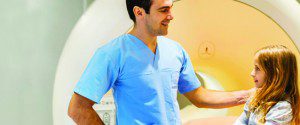 When children know what to expect, they feel more in control. Some imaging centers now help educate young children about MRIs and CT scans by role-playing the procedures using dolls and small toy scanners. Studies have shown that these, and similar educational techniques designed for children, can reduce anxiety and often eliminate the need for sedation.
When children know what to expect, they feel more in control. Some imaging centers now help educate young children about MRIs and CT scans by role-playing the procedures using dolls and small toy scanners. Studies have shown that these, and similar educational techniques designed for children, can reduce anxiety and often eliminate the need for sedation.
MAGNETIC RESONANCE IMAGING
(MRI) SCAN
An MRI is a way of taking pictures of the inside of the body without using X-rays or radiation. The MRI machine uses a large magnet, radio waves, and computers to take pictures of your child’s body.
How to prepare your child for an MRI:
You will be asked about any metal in your child’s body or clothing. Please dress your child in clothing with no metal snaps, zippers, or rivets. If you go with your child to the MRI area, you will be asked if you have any metal in your body or clothing, and you will also need to dress in clothing that does not include metal.
Your child may be scheduled for an MRI with sedation. If this is the case, you can prepare by helping your child understand what he will experience before receiving sedation. You and your child will meet with a sedation nurse, certified registered nurse anesthetist (CRNA), anesthesiologist, and possibly a child life specialist before the MRI.
• Your child will need to lay still and quiet.
If your child is scheduled for an MRI without sedation or is scheduled with sedation but would like to attempt the MRI without sedation, there are a few ways to be prepared.
• Your child can practice laying still and quiet for about 30 minutes to see whether or not he would be able to do this during the MRI.
• Talk with your child about the loud noises they will hear during the MRI, and that they will be in a machine that looks like a tunnel.
• If the staff approves, you may stay in the MRI room with your child.
NUCLEAR MEDICINE SCAN
A nuclear medicine scan involves taking pictures of parts of your child’s body. A staff member will inject medicine inside your child’s IV. The medicine includes a small amount of a radioactive substance. For a short time, this substance will give off gamma rays. These rays can be seen and recorded by a nuclear medicine camera.
The radioactive substance will leave your child’s body within hours to a couple days. The time it takes the substance to leave the body depends on the type of radioactive substance used and the type of nuclear medicine test performed. The scan is not harmful to your child.
How to prepare my child for a PET scan:
• During the PET scan your child will need to lie still on a scan table in a machine that looks like a tunnel.
• The length of the scan differs depending on how tall your child is. Generally, the scan will take 25–45 minutes to complete.
• This machine makes a small amount of noise, but nothing will touch your child during the scan.
• A parent may remain in the room during the scan if medically permitted by staff.
How to prepare my child for a bone scan or
liver/spleen scan:
• During these scans your child will need to lie still on a scan table in a machine that looks like a short tunnel.
• At times, certain parts of the machine may come close to your child but will not touch him.
• This machine makes a small amount of noise.
• A parent may remain in the room during the scan if the child is not receiving sedation.
During all scans it is important for your child to remain still if he is not sedated.
COMPUTED TOMOGRAPHY (CT) SCAN
A CT scan uses X-rays to create pictures of cross-sections of the body.
• During a CT scan your child will need to lie still for 5–20 minutes, depending on what part of the body is being scanned.
• The CT scanner sounds like a washing machine spinning when pictures are being taken.
• The majority of patients are not sedated for CT scans.
• You will be able to stay in the room with your child during the CT scan if medically permitted by the staff.
X-RAY
An X-ray produces images of the structures inside your child’s body.
• During an X-ray your child will need to lay still or stand still, depending on what part of the body is being scanned.
• You will be able to stay in the room with your child during the X-ray if medically permitted by the staff.
ULTRASOUND
An ultrasound uses high frequency sound waves to produce images of structures inside your child’s body.
• During an ultrasound your child will need to lie still while the ultrasound technician puts a warm gel on a tool called a transducer and gently moves it over the skin of the area being examined.
• The ultrasound should cause no pain; however, your child may experience discomfort if the area being examined is tender or painful. You will be able to stay with your child during the test if medically permitted by staff.
If you have questions about how to prepare your child for any diagnostic imaging test, please talk to your physician or call the team at Naples Diagnostic Imaging Center at 239-593-4200.
Naples Diagnostic Imaging Center
239-593-4222
www.NaplesImaging.com








